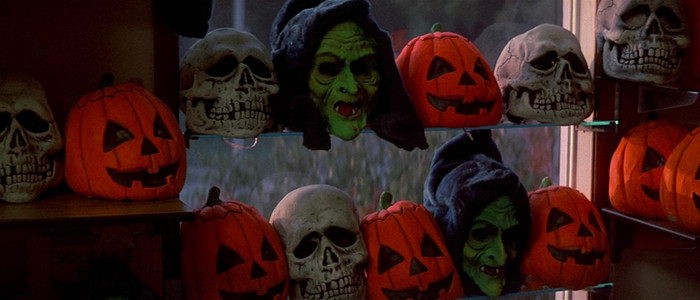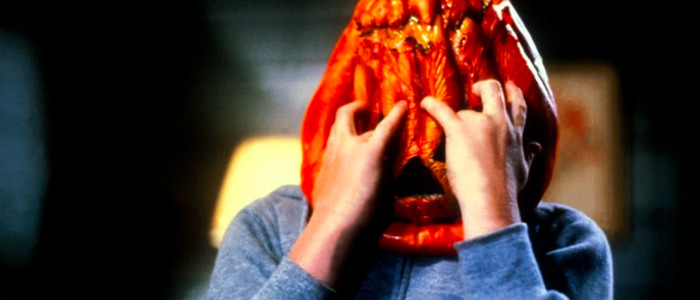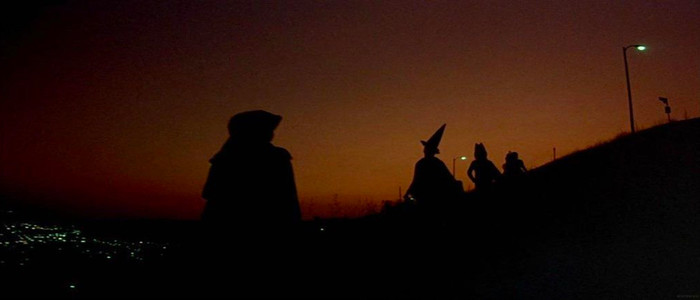The Unpopular Opinion: 'Halloween III: Season Of The Witch' Is The Best 'Halloween' Sequel
(Welcome to The Unpopular Opinion, a series where a writer goes to the defense of a much-maligned film or sets their sights on a movie seemingly beloved by all. In this edition: Halloween III: Season of the Witch, which famously abandoned Michael Myers, is actually the best of the many Halloween sequels.)The Halloween franchise has given birth to an entire candy bowl full of sequels, yet none are as reviled as Halloween III: Season of the Witch. Even the abysmal Halloween: Resurrection, which features Busta Rhymes drop-kicking Michael Myers, seems to garner more respect than Season of the Witch. It's the black sheep of the family. The odd film out. The one that even the film's producer Irwin Yablans thinks of as a huge mistake.Yet beneath all the ire lies a wonderful, weird horror movie that should've been the start of bigger and better things for the franchise. Instead, the film disappointed so much that it would be another six years before another Halloween film graced movie screens, in the shape of a film that returned the franchise to its normal roots and take it down a path toward mediocrity.Major spoilers are found throughout this article.
The Night No One Comes Home
It's almost time, kids. Halloween is right around the corner, and with it comes the inspiration to watch and rewatch horror movies in the spirit of the season. At the forefront of them all is John Carpenter's immortal classic Halloween, a film that seems to personify the holiday in all its dreadful glory. Yet there's a Halloween sequel that actually does an even better job of encapsulating that most horrific of holidays. A film that takes the very essence of All Hallow's Eve and boils it down into a tale of terror that thrills and delights in equal measure.
And most people hate it.Carpenter's 1978 Halloween was lean and mean. A slasher movie ahead of its time, back before general audiences even knew what a slasher movie was. A suburban Halloween is turned upside down when the silent, nearly inhuman murderer Michael Myers returns to his hometown and begins killing off innocent young teens, one by one. With his white, featureless mask and his cold, unrelenting determination to kill, Michael Myers made the boogeyman into something real. No longer resigned to the stuff of nightmares and children's closets, he was now out in the real world, and seemingly nothing would stop him.The first Halloween ends on a terrifying note: after being shot multiple times, Michael vanishes, but we still hear his heavy breathing behind his mask. That breathing is everywhere, signaling that Michael Myers could be anywhere – anywhere at all. Watching, and waiting. The surprise success of the film inspired a sequel, Halloween II. John Carpenter and Debra Hill, the writers of the film film, penned the script, which is set only minutes after the previous film ends. Already, Carpenter was showing signs of fatigue regarding his hit creation. He declined to direct Halloween II. The filmmaker didn't even want a sequel to begin with, but the promise of more money swayed him.When it came time to make the inevitable Halloween III, Carpenter and Hill hit upon what they thought was a brilliant idea. They would move away from the established timeline of the franchise and tell a completely different story set at Halloween. No more Michael Myers, no more teens being stalked in the shadows. Instead, they would plan to release a new film every year on Halloween that would tell a completely different story in the spirit of the season. It would be like a TV anthology on the big screen. Creatively speaking, this is a brilliant idea. Here was the chance to do something with a horror franchise that no other series was even attempting at the time. Many years later, Ryan Murphy would be applauded for doing something similar with his American Horror Story series. At the time of Halloween III, however, audiences were apparently just not ready.But Carpenter and company didn't know that yet. They were all convinced of the genius of their idea, and set about making it a reality. Nigel Kneale, a British science fiction author, was hired to pen the script. Carpenter was a fan of Kneale's Quatermass series, based around a BBC Television character who explores the supernatural. The script Kneale turned in was more psychological than horrific. "The main story had to do with deception, psychological shocks rather than physical ones," the writer said. After Kneale turned his script in, Carpenter set about polishing it up. In the meantime, Tommy Lee Wallace, the art director for the original Halloween, was hired to direct the film. Wallace had been offered the director's chair for Halloween II as well, but had turned it down due to lack of interest. It was the concept of doing something completely new with the franchise, and avoiding Michael Myers altogether, that hooked him for Halloween III.Years later, Wallace would acknowledge the biggest problem with Halloween III was a failure to clue audiences in on just what the hell was going on. A clever marketing campaign could have potentially saved the film, as far as box office returns go. But there wasn't even the tiniest bit of effort to warn fans of the franchise about what they were in store for. As a result of this, people came away perplexed. Just what was going on here? Where was Michael Myers?Like the other Halloween films, Halloween III: Season of the Witch is set on the days leading up to the holiday. Yet while the other entries in the series tell a story of a stalker with a knife, Season of the Witch has more in common with Invasion of the Body Snatchers. There's an air of science fiction to the proceedings, albeit one tinged with sudden bursts of horrific violence.
The Hills Ran Red
Season of the Witch opens with a man desperately trying to evade a group of silent pursuers. Clutching a bright orange Halloween jack-o-lantern mask, the man ends up in the hospital, croaking out a dire warning: "They're going to kill us all." It's not long after the man ends up in the ICU that he's brutally murdered by a man who proceeds to set himself on fire in his car to avoid capture.These mysterious goings on draw the attention of Dr. Daniel Challis, played by horror genre staple Tom Atkins. As played by Atkins, Dr. Challis is a beer-swilling ladies man, not averse to blowing off his ex-wife and kids to grab a six pack and hightail it out of town. He forgets things easily, and buys his children cheap plastic Halloween masks, much to their chagrin. They'd rather have the ultra-cool Silver Shamrock masks that keep popping up on a series of incessant commercials. There are three masks: a green-faced witch, a cracked and grinning skull, and a day-glow jack-o-lantern – the same mask the now-dead man was clutching when he was brought into the hospital. Atkins' character, likable yet not adverse to some casual sexual harassment with the nurses he works with, is an unlikely hero, and his presence here is a true indication on how different the franchise wanted to be. The protagonists of the previous Halloween films were hapless teens. Atkins' Dr. Challis is a much older man; an adult drawn into a bizarre nightmare. Challis teams up with Ellie Grimbridge (Stacey Nelkin), daughter of the murdered man, and the two begin an X-Files-like investigation into just what happened to Ellie's father.
Challis and Ellie's investigation lead them to the quiet little California town of Santa Mira, home of Silver Shamrock Novelties, makers of those fine Halloween masks that keep showing up on all those commercials. Santa Mira is a company town, completely committed to Silver Shamrock. Cameras line the streets, keeping a watchful eye on everyone and everything. And anywhere that Challis and Ellie look, they spot mysterious, silent men in suits. Men who look and behave very similar to the man who killed Ellie's father, then torched himself.Silver Shamrock is owned and operated by Conal Cochran (Dan O'Herlihy), "inventor of the practical joke." With his Irish brogue and grandfatherly manner, Cochran gives off an air of warmth and charm, but underneath it all you can sense something sinister lurking. And there is: Cochran has devised a plan to kill millions of children with his Halloween masks. Using witchcraft and chunks stolen from Stonehenge (look, just go with this, don't try to make sense of this), Cochran will beam a televised signal out on Halloween night, and all children wearing one of his Silver Shamrock masks will succumb to a horrible fate. The masks will melt and disintegrate around the children's heads, and from them insects and snakes will issue forth. Again, none of this makes much sense, but it's twisted and strange enough to send a chill down your spine. While most horror films tend to shy away from inflicting actual harm on children, Halloween III goes all-in, including a scene where a young test subject dies before our eyes, clutching at the rotting, bug-spewing mask melded to his head.The key to making this plot work rests solely in O'Herlihy's hands. The actor never winks at the audience; never lets on how goofy this entire concept is. Instead, he plays it all with a malevolent grin. "You don't really know much about Halloween," he tells Challis at one point. "You thought no further than the strange custom of having your children wear masks and go out begging for candy...It was the start of the year in our old Celtic lands, and we'd be waiting in our houses of wattles and clay. The barriers would be down, you see, between the real and the unreal, and the dead might be looking in to sit by our fires of turf. Halloween... the festival of Samhain! The last great one took place three thousand years ago, when the hills ran red with the blood of animals and children...It was part of our world... our craft...To us, it was a way of controlling our environment. It's not so different now... it's time again. In the end, we don't decide these things, you know; the planets do. They're in alignment, and it's time again."Challis is able to make his escape from Santa Mira. Ellie isn't so lucky. Frantically, Challis calls the TV stations, begging them to stop airing the Silver Shamrock commercial that will potentially kill millions of children. All but one channel complies, and the film ends on an ambiguous note, with Challis screaming into a phone as we're left wondering if the final commercial was killed before it had a chance to kill millions of children on Halloween night.
Trick or Treat
Had Halloween III not been saddled with the Halloween brand name, the reaction might have been more kind. The subtitle Season of the Witch could've easily served as the proper title, and audiences might not have come away feeling cheated and angry at being denied another murderous Michael Myers adventure. Which is a shame, because Halloween III: Season of the Witch is the best sequel in the franchise. Halloween 4 would bring back Michael Myers, but it would mostly be a rehash of the first film. From there, the franchise would disintegrate into anarchy, featuring Paul Rudd and subplots about cults. This would give way to an inevitable reboot.
Yet Halloween III is special. For one thing, it's the only film in the franchise that fully invokes the atmosphere of Halloween. Carpenter's original, great as it may be, was shot in the spring in California, and it shows. The trees are far too green for its supposed Illinois setting, and a few stray leaves added to the ground by the production team do little to give off an autumnal vibe. Watching Halloween, you always get the sense that it's not really the beginning of fall, when the world is slowly dying and decaying and a new season is beginning. Instead, you can always tell that just off camera, spring, a time of new life, is lurking, still vibrant and lush.
Halloween III doesn't have these problems. There's a chill coming off this film, as if an actual autumn breeze is emanating from the screen. Director of Photography Dean Cundey captures it all in threatening shadows cut with sodium lightning. As the film nears its end, a montage unfolds giving off the truest sense of the holiday ever captured in this franchise. Children decked out in their masks cavort through the night, grabbing fistfuls of candy and scampering on to the next location. At one point, a group of children trek across a dark landscape, silhouetted against a pumpkin-orange sky. Few images in the Halloween series better summon up the true sense of Halloween night as much as this one moment.
Over the years, Halloween III's following has grown. Once shunned and loathed, audiences have learned to accept how unique the film is. Yet the stigma remains. While hardcore horror fans may sing the praises of Season of the Witch, casual movie goers are still apt to shrug the sequel off for its distinct lack of Michael Myers. And while some may come around and admit they like the film despite it's faults, few may want to herald it as the best sequel in the franchise. But this is exactly the honor it deserves. So unconcerned with rehashing the familiar and so content to forge its own path, Season of the Witch ends up being the most memorable sequel in the series.
Halloween III: Season of the Witch is a weird, eerie experience. There are several Michale Myers-centric Halloween sequels that all meld together into one incoherent mess. But there's only one Halloween III, a film unlike any other in the series. There's no sense of safety here; no sense that once the sun rises and Halloween ends, things will be alright. The original Halloween at least had the calming authority figure of Donald Pleasence's Dr. Loomis, the determined monster hunter hell-bent on stopping the boogeyman. There's no such hero here. The best with have is Tom Atkins' beer swilling, womanizing doctor, in over his head and out of his depth. No one else will show up to save the day. Perhaps that's what really turned audiences off at first – the film's refusal to provide anything even slightly comforting. At one point, Atkins' Challis asks Cochran just why he's setting out to slaughter millions of innocent people. "Do I need a reason?" Cochran asks. "I do love a good joke, and this is the best ever: a joke on the children."
In the end, Halloween III: Season of the Witch was playing a trick on its audience. But those who were able to get over that initial shock were in for a treat.
